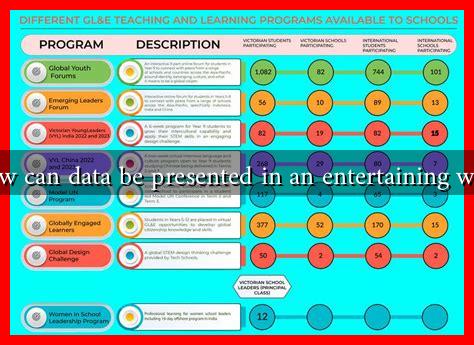-
Table of Contents
How Can Data Be Presented in an Entertaining Way?
In an age where information overload is the norm, presenting data in an entertaining way has become essential for effective communication. Whether in business, education, or media, engaging presentations can transform dry statistics into compelling narratives that resonate with audiences. This article explores various methods to present data entertainingly, supported by examples and case studies.
The Importance of Engaging Data Presentation
Data presentation is not just about displaying numbers; it’s about storytelling. Engaging presentations can:
- Enhance understanding and retention of information.
- Encourage audience interaction and participation.
- Make complex data accessible to a broader audience.
- Drive decision-making and inspire action.
According to a study by the International Data Corporation, the global data sphere is expected to reach 175 zettabytes by 2025. With such vast amounts of data, the need for effective presentation methods is more critical than ever.
Creative Visualization Techniques
One of the most effective ways to present data entertainingly is through creative visualization. Here are some popular techniques:
- Infographics: Infographics combine visuals and text to tell a story. They can simplify complex data and make it visually appealing. For example, the Visual Capitalist creates stunning infographics that break down economic trends and statistics.
- Interactive Dashboards: Tools like Tableau and Power BI allow users to interact with data in real-time. This interactivity can engage users and provide personalized insights.
- Animated Charts: Animation can bring data to life. For instance, the animated bar charts created by Information is Beautiful effectively illustrate changes over time, making the data more relatable.
Storytelling with Data
Data storytelling is a powerful technique that combines data analysis with narrative elements. Here’s how to effectively tell a story with data:
- Identify a Clear Message: Start with a central theme or message that you want to convey. This will guide your data selection and presentation style.
- Use Anecdotes: Incorporate personal stories or case studies that relate to the data. For example, a company might share customer testimonials alongside sales data to illustrate the impact of their product.
- Build a Narrative Arc: Structure your presentation like a story, with a beginning (introduction of the problem), middle (data analysis), and end (conclusion and call to action).
For instance, the popular TED Talk by Hans Rosling, “The Best Stats You’ve Ever Seen,” uses engaging visuals and storytelling to present global health data, making it both informative and entertaining.
Gamification of Data
Gamification involves incorporating game-like elements into data presentation to enhance engagement. Here are some effective strategies:
- Quizzes and Polls: Use interactive quizzes to test audience knowledge about the data. Tools like Kahoot! can make learning fun and competitive.
- Data Challenges: Create challenges where participants analyze data and present their findings. This encourages collaboration and deeper understanding.
- Reward Systems: Implement a points or rewards system for participation, which can motivate audiences to engage more actively with the data.
Conclusion
Presenting data in an entertaining way is not just about aesthetics; it’s about making information accessible and engaging. By utilizing creative visualization techniques, storytelling, and gamification, data can be transformed from mere numbers into compelling narratives that captivate audiences. As we continue to navigate an increasingly data-driven world, mastering these presentation techniques will be crucial for anyone looking to communicate effectively. Remember, the goal is not just to inform but to inspire action and understanding through the art of data presentation.

